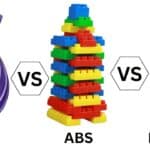
3D printing has revolutionized the way we design and manufacture objects. One of the key decisions in 3D printing is selecting the right material for your project. With a vast array of materials available, each with its own unique properties, the choice can be daunting.
Affiliate Disclosure
We participate in Amazon affiliate programs, earning fees from qualifying purchases via links at no extra cost to you. It’s how we keep this blog rolling and my 3D printers buzzing with fresh filament for reviews like this one!
To simplify this process, we have created this free tool, 3D Printing Material Comparison Calculator, which has emerged to help users make informed decisions.
Notes:
Prices can vary based on brand, supplier, and specific formulations.
Specialty materials like PEEK and carbon fiber-reinforced filaments tend to be more expensive due to their advanced properties and applications.
The ranges provided are estimates based on current market trends and may fluctuate over time.
What is this 3D Printing Material Comparison Calculator
The 3D Printing Material Comparison Calculator is a user-friendly tool that provides detailed information about various 3D printing materials. By selecting a specific material from a dropdown menu, users can access a comprehensive overview of its properties, including:
- Strength: Measures the material’s ability to withstand stress and deformation.
- Flexibility: Indicates the material’s capacity to bend without breaking.
- Impact Resistance: Assesses the material’s ability to resist damage from impact.
- Cost: Provides an estimate of the material’s cost per kilogram.
- UV Resistance: Measures the material’s ability to withstand degradation from UV light.
- Eco-friendliness: Indicates the material’s environmental impact.
- High Detail: Assesses the material’s ability to produce fine details and intricate designs.
- Water Resistance: Measures the material’s resistance to water absorption and damage.
- Heat Resistance: Indicates the material’s ability to withstand high temperatures.
- Lightweight: Assesses the material’s density and overall weight.
- Biodegradable: Indicates whether the material is biodegradable or not.
- Use Cases: Provides examples of common applications for the material.
How to Use this 3D Printing Material Comparison Calculator
- Select a Material: Choose the material you’re interested in from the dropdown menu.
- View Material Properties: Once you select a material, the calculator will display a detailed breakdown of its properties.
- Compare Materials: You can easily compare different materials by selecting them one by one and reviewing their properties.
Points to Consider When Choosing a 3D Printing Material
While the 3D Printing Material Calculator is a valuable tool, it’s essential to consider other factors when selecting a material for your project:
- Project Requirements: Consider the specific needs of your project, such as strength, flexibility, heat resistance, and water resistance.
- Printer Compatibility: Ensure that your 3D printer is compatible with the chosen material.
- Budget: Factor in the cost of the material and any additional processing or finishing costs.
- Post-Processing: Some materials may require additional post-processing steps, such as sanding, painting, or heat treatment.
- Environmental Impact: If sustainability is a concern, consider eco-friendly materials like PLA or wood-filled filaments.
Conclusion
The 3D Printing Material Comparison Calculator is a valuable resource for anyone involved in 3D printing. By providing comprehensive information about various materials, it empowers users to make informed decisions and select the best material for their specific needs. By carefully considering the factors discussed above, you can ensure successful 3D printing projects and achieve optimal results.
Frequently Asked Questions (FAQs)
What is the most affordable 3D printing filament for beginners?
PLA is generally considered the most budget-friendly filament for beginners. It’s easy to print with and has a wide range of applications.
Which filament is best for printing strong and durable parts?
ABS and Nylon are excellent choices for printing strong and durable parts. ABS is impact-resistant, while Nylon offers high tensile strength and flexibility.
What filament should I use for printing flexible parts?
TPU/TPE filaments are ideal for printing flexible parts. They offer rubber-like properties and can be used for a variety of applications, such as phone cases and wearable devices.
What is the most heat-resistant filament?
PEEK is one of the most heat-resistant filaments available. It’s often used in high-performance engineering applications.
What filament should I use for outdoor applications?
ASA is a good choice for outdoor applications as it is UV-resistant and can withstand harsh weather conditions.
References:
Here are the references from which the data regarding the properties and prices of various 3D printing materials were derived:
- Wevolver: This source provides a comprehensive overview of different types of 3D printing materials, including their properties and applications, which helps in understanding the mechanical characteristics of materials like PLA, ABS, and Nylon. Wevolver.
- ScienceDirect: This article reviews processes, materials, and applications in 3D printing, detailing the properties and uses of various material classes, including thermoplastics and composites. ScienceDirect.
- Tesseract 3D: This supplier provides specific pricing and technical details for various filaments, including ASA and PETG, which are relevant for understanding current market prices for these materials. Tesseract 3D – ASA Filament, Tesseract 3D – PETG Filament.
- MDPI: This source discusses advancements and limitations in 3D printing materials and technologies, providing insights into various material properties and their applications. MDPI.
- Raise3D Blog: This blog discusses the costs associated with 3D printing, including material costs and factors influencing overall printing expenses. It provides context for understanding how material pricing fits into the broader landscape of 3D printing costs. Raise3D.













